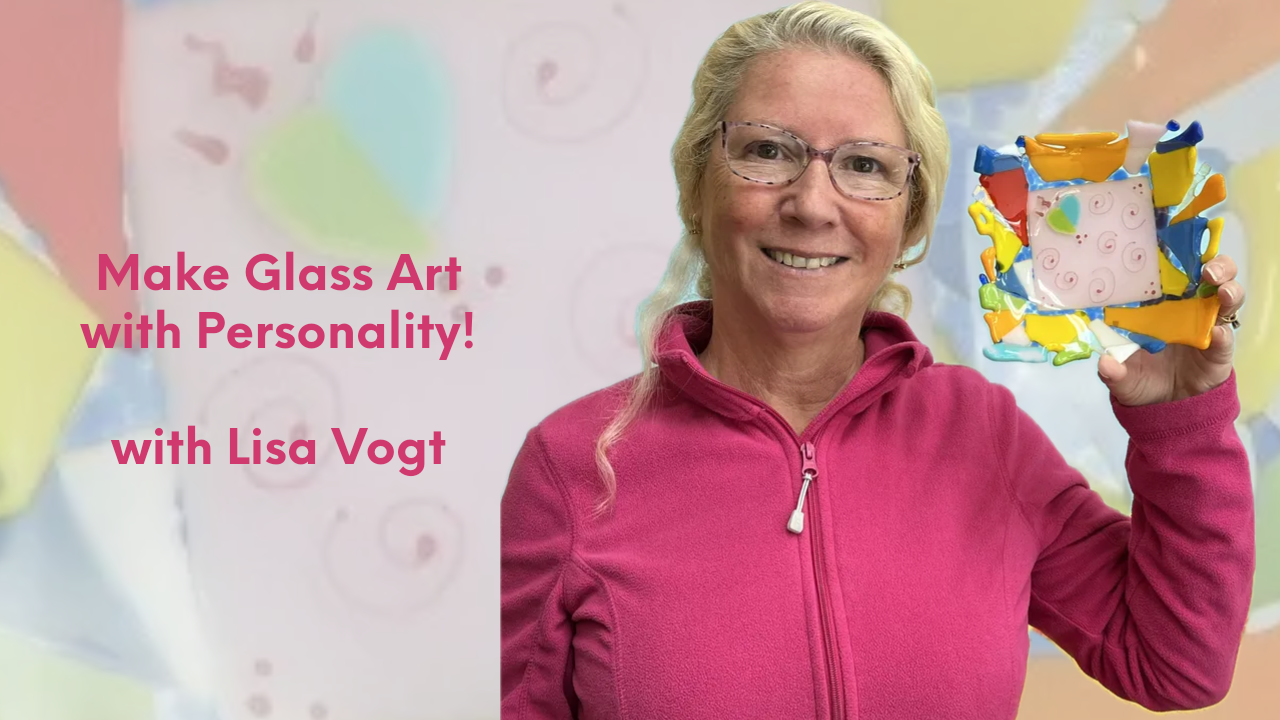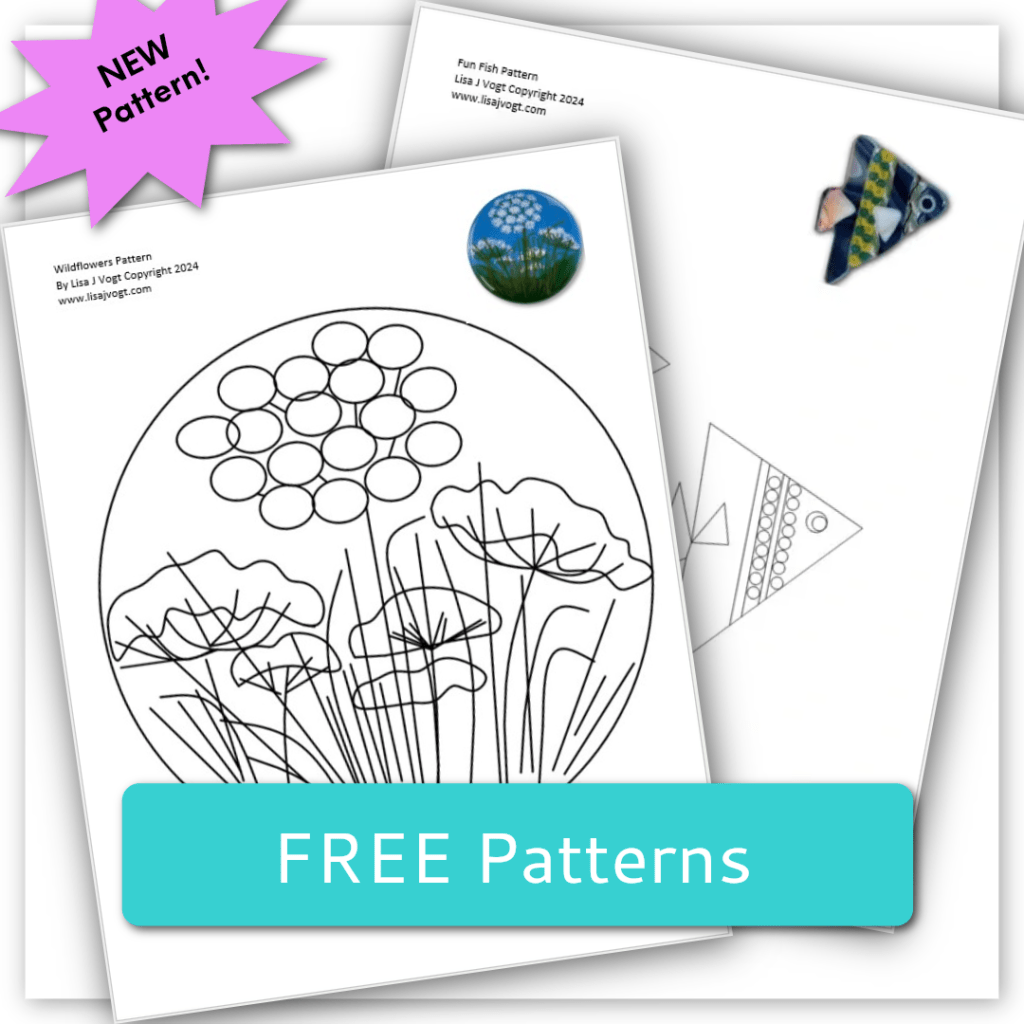

Succulents as seen in Simple Pleasures Glass Fusing with Lisa Vogt video.
When I step into my studio, I know the subject or focal point of the fused glass project I intend to make. I may plan to build a piece with a sailboat or something with a geometric pattern. It’s that basic plan that fuels my artistic actions. Making the subject is easy. But I don’t stop there.
Consider the background space.
The background is equally, and possibly more important than the subject. How the background is handled can dramatically improve the power and appeal of a work of art. A good background enhances the focal point. It reinforces the subject with images or shapes that establish setting or create a mood that further support the artist’s specific visual goals.
Evolution of a design background.
Let’s examine a few fused glass designs together. I’ll show you how the addition of simple, complementary elements can sway the design direction. And how the choices you make can produce unique, exciting designs.
I start my design process with the specific subject I want to create. In this case I wanted to make succulent flowers. Notice how simple the succulent flower pattern is without a background design in place.
I could have used plain blue and green glass for the background to suggest an outdoor location. That would have worked fine. But, with a little more thought, creativity, and time I created a background that entirely changed my subject for the better. I used hand-made stencils along with powder frit to add a garden setting to my flowers. It worked. The subtle leafy pattern and hint of blue sky dramatically increase the charm and beauty of my finished bowl.

Succulents as seen in Simple Pleasures Glass Fusing with Lisa Vogt video.
For my next design my focal point was bees. It’s such a simple yet bold subject that I could have easily executed it beautifully with a plain background. But plain isn’t my style. I could have placed them in any number of settings. I thought about sitting them on top of flowers, or on the side of a beehive hanging from a tree limb. But at the time, the rich golden colors and angular geometry of a honeycomb appealed to me more.
Look at the bee pattern alone. Then look at it again in the completed piece. You must admit the addition of the honeycomb background seriously increased the bees artistic influence on the finished piece of art.

Buzzing Bees as seen in Simple Pleasures Glass Fusing with Lisa Vogt video.
Another simple design I favor is a wine glass. It’s graceful shape and promise of relaxing with good company make it dear to my heart. The problem is the basic design lacks personality. Its screaming for a creative treatment that takes us away to a picturesque retreat. This pattern is great for imagining different background settings and how they would change the art’s mood. For example, picture a background with a fireplace and open book. Or how about a loaded cheese board with fruit or a sunny beach with palm trees. Better yet, make a dimly lit cave with a witch’s caldron and spider webs in the background. Each of these design ideas are easy to make. So, there’s no excuse not to try it for yourself. And there’s no doubt that the life they would breath into the original design would make it better.

Wine Glass as seen in Simple Pleasures Glass Fusing with Lisa Vogt video.
These examples illustrate the incredible impact the background has on your fused glass design. I hope I’ve given insight into my design process and simple ideas you can use to liven up your own artwork.
Knowing what you want to make is exciting. But don’t let your imagination stop with the focal point. Do more. Customize the background to transform ordinary patterns into something special that reflects your unique and flourishing artistic style.

Excerpt and designs from my Simple Pleasures video.
NEW Advanced Glass Fusing Class

4-Day, Hands-on Class, Wesley Chapel, FL
May 28-31, 2024
YOU can make gallery quality fused glass art! You’ll love the personalized instruction in this exciting advanced technique, artistic awakening and skill building workshop. This is the turning point experience you’ve been waiting for.
Someday is here! What are you waiting for? You’re in your prime. You’re at the peak of your interest in glass fusing. Take the next step and raise your artwork to an exciting new level of sophistication.
Join me for this intense workshop held in my private studio.
Wesley Chapel, Florida, 4-Day, Hands-on, Class size is limited.
In this class, you will push the boundaries art glass imposes. Students will explore innovative approaches to design and combine multiple advanced techniques to construct original art that reflects their own personal style. You’ll enjoy: the one-on-one instruction, making multifaceted projects, the well-equipped classroom, and the intimate class size.
You’ll love the concentrated, in-depth study and creative momentum you’ll gain while actively producing, nonstop for four consecutive days. You’ll leave class with a working knowledge of kiln operation, custom project specific firing guides, and the inspiration you’ve been craving to go bigger and do more elaborate works of fused glass art!
Join me and take your glass fusing to the next level!
Follow my blog for weekly inspiration sent to your inbox!
Happy Fusing!
Lisa
Knowledge – Confidence - Inspiration
Premium Video Courses by Lisa


































































































